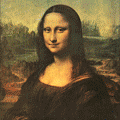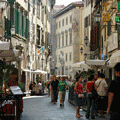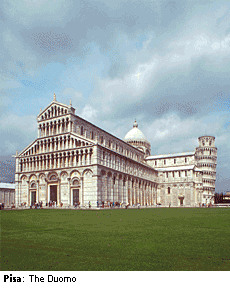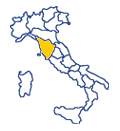Churches and Museums
Campo dei Miracoli. One of the most famous and admired squares in the world, it was requested by the city government at a time when Pisa was at its most splendid. It is formed by a complex of four buildings, constructed by the most genial architects of that era in a uniquely recognizable Pisan Romanesque style, which sees alternating rows of white and greenish-gray stone.
The Duomo was built between the 11th and 12th centuries, but was later subject to various restructuring work, especially after the great fire of 1595. The facade forms a scenic backdrop, with four rows of columns and decorations in colored marble on the lower part. All the external surfaces are emphasized by the horizontal rows of black and white, with a beautiful elliptic dome of clear Islamic influence. The interior forms a Latin cross, divided into five naves by heavy granite columns. The sight is incredible, thanks to the geometric decorations of polychrome marble and the seventeenth-century coffered ceiling. The original decorations were almost all destroyed during the fire of 1595. A masterpiece of Italian Gothic sculpture from the fourteenth-century remains, the beautiful Giovanni Pisano pulpit, as well as the apse mosaic.
The Leaning Tower represents one of the symbols of Italy around the world. Designed as a bell-tower for the cathedral, work began in 1174 based on a project by Bonanno Pisano. It was completed in the 14th century. The round tower is composed of a base with blind arches supporting six loggia tiers that culminate in an elegant bell chamber.The ground already began to show signs of subsidence in 1185 which caused the works to come to a halt for almost a century. In 1990 its gradient reached a worrying 4.5 meters and the tower was closed for restoration work. It was reopened to the public in 2001, after eleven years of difficult work on the building and the ground underneath, reducing the tower's gradient by 40 cm and bringing it back within safety standards.Visiting hours vary from season to season. Tours can take a maximum of 40 people accompanied by authorized staff. Tickets can be purchased from the ticket office near the Leaning Tower or on the "Opera Primaziale" website www.opapisa.it.
The Baptistery. Work began in 1152 on the construction of a new baptistery, which blends well with the cathedral in terms of position, size, materials and style. Construction lasted until the end of the fourteenth-century and included the work of various architects, explaining the Romanesque and Gothic mix in the monument. The shape of the baptistery had to evoke that of the Holy Sepulcher. In the 12th century, Nicola and Giovanni Pisano changed the original building, completing it with a crown of arches and pinnacles. Inside, one can admire the beautiful baptismal font and, near the altar, the pulpit, the work of the great Nicola Pisano.
Santa Maria della Spina. This small church on the banks of the Arno is an extraordinary gem from Gothic Pisa. The name derives from the fact that a thorn from the crown of Jesus Christ has been preserved here for centuries, now exhibited in the Church of Saint Chiara. The church is covered in dual-colored marble rows and decorated with elegant spires, tympanums and tabernacles. The rich sculpture decoration was carried out by important fourteenth-century Pisan sculptors. Inside, one finds the statue of Andrea Pisano.
Church of San Paolo a Ripa d'Arno. This beautiful church was built between the 9th and 10th centuries and is one of the most splendid examples of Pisan Romanesque architecture in existence. It was recently renovated and restored to its original shape. Inside, the church is huge with three naves with heavy granite columns and capitals featuring archaic figures; it hosts various works of art from medieval times. The beautiful Chapel of Sant'Agata is located beside the church. It dates back to the 11th century and has a unique octagonal shape.
San Michele in Borgo It was built between the 10th and 11th centuries in a transition style of Pisan Romanesque and Gothic architecture. The beautiful facade above the trusses hosts three rows of arches, a rose window and a tabernacle with statues dating from the fourteenth century. Inside, the three considerably sized naves are divided by columns and pillars and the church contains various works of art.
San Zeno Abbey Reopened in 2000 following intense restoration work, this abbey hosts contemporary art exhibitions and concerts. San Zeno Abbey is unusual in its curious mix of architectural styles and orientation, as is easily noted by its facade. The facade has an ornate Romanesque geometrical design.
The Palazzo Reale National Museum was prepared in 1989 to host numerous works of art belonging to the successive courts of the city government, including the Medici, Lorena and Savoia courts, as well as some private collections. The location is one of the most important buildings in the city, the official residence of the Medici and Lorena courts, and today continues to maintain the appearance of an aristocratic residence, with fittings and furniture from the 17-19th centuries. The works exposed offer great variety: from official portraits of the courts to historic armors, right up to the Antonio Ceci collection with Italian and Flemish paintings.
The San Matteo National Museum hosts works originating from the main churches in the city and territory. The collection includes paintings, sculptures and ceramics. The medieval collection is very impressive with around two hundred paintings dating from the beginning of the XII to the sixteenth-century, with names such as Giunta Pisano, Simone Martini, Masaccio and Beato Angelico among the many artists.
Museum of Ancient Ships in Pisa. In 1998, during the works carried out in the area around Pisa San Rossore Station, the remains of the ancient port in Pisa were brought to light. At a depth of circa 5 meters, an impressive series of wrecks placed one on top of the other emerged, dating from between the end of the Hellenistic Period and the Late Roman Period. The Permanent Exhibition of Ancient Ships will be hosted in the ancient Medicei Arsenals, on Lungarno Simonelli. Currently, the exhibition is closed due to restructuring work on the arsenals and the restoration of the ships. Opening is scheduled by the end of 2006.
Piaggio Museum, in Pontedera. In three thousand square meters of exhibition you can admire the Vespa, Piaggio and Gilera collections. The most important part of the museum is the Vespa collection, with its 50 years of production. As well as the first prototypes, you can admire gems such as the Vespa “Montlhéry” and the Vespa “Siluro”, two speed models, and unique models such as the “Vespa Dalì”, designed by the Catalan artist in ’62. As well as the Vespas, all the transport vehicles produced over the one hundred and ten years of Piaggio history are on show.
Photos courtesy of APT Pisa
Go to directories of the Web Sites
|





